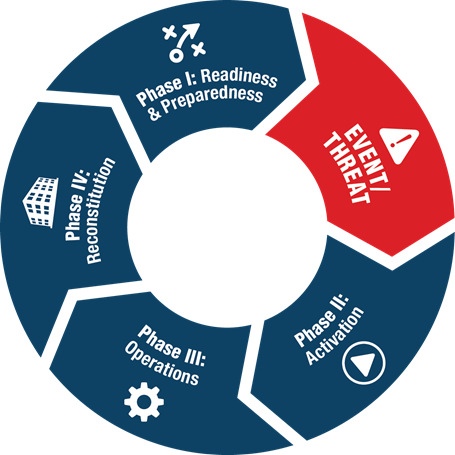A Continuity of Operations Plan (COOP), also known as a Business Continuity Plan (BCP) is a collection of resources, actions, procedures, and information that is developed, tested and kept ready in the event of a disruption of operations. It helps prepare departments and units to continue their essential functions after a disaster or other disruption. Having a COOP will help to minimize impacts on your department during an emergency or disruptive event through:
- Recognizing and prioritizing critical work functions within your department
- Organizing contact information for your essential personnel and backup personnel
- Coordinating important resource information into a single plan that can be quickly referenced and periodically reviewed and updated
Developing your COOP, and continuing to review it for any needed updates, will help to assure that your team reduces any unnecessary down-time during an emergency or disruptive event and return to normal operations as quickly as possible.
Continuity of Operations Plan (COOP) Quick Start Guide
Follow our step-by-step guide to develop your COOP. Read more about the resources you will use to make your plans and organize the actions you will take to help your team avoid unnecessary disruptions during an emergency or other disruptive event.
The Continuity Phases
There are four phases of the continuity process, beginning with developing your COOP and training to stay prepared.
Phase I: Readiness and Preparedness
The ability of an organization to respond to a COOP activation.
This phase includes all organization, continuity readiness and preparedness activities including:
- Plan development, review and revision
- Testing the plan and engaging in training and exercise activities with your team
- Risk management activities
- Integrating readiness and preparedness measures into daily activities
- Providing guidance to your team about what to expect during an emergency or disruptive event
During this phase, the university is operating under normal conditions, and individual departments are creating their COOP planning and training.
Phase II: Activation
This phase includes the activation of your COOP and supports the procedures that enable your department’s continued performance of its essential functions.
Activation of your COOP may also include a possible transition to operating from alternate locations to reduce disruption to operations. Communication is important including:
- Activation of continuity plan in response to an event
- Alerts and notifications to your team
- How essential personnel will remain accountable
- Relocating work processes to support essential functions, if necessary
During this phase, the university may be operating under special or emergency conditions, and the university’s emergency operations center (EOC) may be partially or fully activated. EOC personnel are alerted to monitor or report to the EOC once activated. Non-essential staff may be advised not to come to campus until normal operations can resume.
Phase III: Operations
During this phase, your department will execute the strategies identified in your COOP to ensure that your department’s essential functions are still accomplished during the emergency or disruptive event.
- Your department will focus on the essential work functions you have identified for your department in your COOP.
- Critical staff may operate from the alternative locations you identify in your COOP, or telework.
- Critical staff may also follow the temporary assignments, shifts, rotations or schedules you identify in your COOP for an emergency or disruptive event.
During this phase, the university focuses on its essential operations too. These are coordinated through the EOC, when it is activated. Essential staff from the university’s Emergency Management Task Force may also operate under alternate schedules during the incident, and the university’s communications may be coordinated through the EOC.
Phase IV: Reconstitution
The last continuity phase is where your team will return to normal operations once the university’s leadership determines normal operations can be safely resumed.
Phase IV includes:
- Returning to your department’s original work facility, regular staffing plans and schedules, or relocating to a new facility for the long term
- Reviewing your COOP and how well it worked for your team. Using your team’s feedback, you may also determine that adjustments to how your team’s essential functions are accomplished in the future need to be made.
Planning for recovery of the organization occurs during Phase 1, but Phase IV may often begin soon after the emergency or disruptive event concludes.
Your department and the university are responsible for developing executable plans to reduce disruptions to critical functions and return to normal operations as soon as possible. Your team can achieve this by developing a COOP that can be used during any emergency or disruptive event and reviewing it at least annually.
